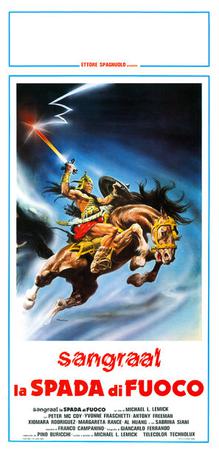| The Sword of the Barbarians | |
|---|---|
 | |
| Directed by | Michele Massimo Tarantini |
| Screenplay by | Piero Regnoli [1] |
| Produced by |
|
| Starring |
|
| Cinematography | Pasquale Fanetti [1] |
| Edited by | Alessandro Lucidi [1] |
| Music by | Franco Campanino [1] |
Release date |
|
Running time | 85 minutes [1] |
The Sword of the Barbarians ( Italian: Sangraal, la spada di fuoco/ Sangraal, the Sword of Fire) is a 1982 sword and sorcery film written and directed by Michele Massimo Tarantini and starring Peter McCoy and Sabrina Siani. [2][ page needed] [3][ page needed] [4][ page needed] The film is also known as Barbarian Master. The village raid scene in this film was re-used a year later in another Italian film, The Throne of Fire (1983). [5]
Plot
The movie introduces Sangraal, son of king Ator, whose realm and people are destroyed by evil warlord Nantuk. Sangraal and the remainder of his people flee his wrath and begin searching for a new home. After defending some villagers from an attack by Nantuk's troops, the villagers gladly accept the newcomers as part of their community. Their leader, Belem, even offers Sangraal co-rulership. Meanwhile, the warlord - who has assumed kinghood after Ator's fall - has angered the Goddess of Fire and Death, to whom he owes his power and whose cult he leads. She demands that Sangraal be sacrificed or Nantuk will lose his power, his kingdom, and his life.
Nantuk sends out more men to destroy the village sheltering Sangraal, and has his troops murder everyone while the captured and crucified protagonist must watch. He witnesses his wife's death at the hands of the Goddess of Fire and Death and falls unconscious before being freed by Belem's daughter, Ati, and Li Wo Twan, a travelling archer.
After Ati and Li Wo Twan patch the barbarian up, Sangraal decides to visit the powerful wizard Rudak, who might have the power to bring his wife back to life. Meanwhile, Nantuk promises his Goddess to torture Sangraal and cast him into her fiery altar with his own hands.
The trio narrowly manages to escape several ambushes and finally makes it to the mountain where Rudak dwells. Rudak, however, convinces Sangraal to finally let go of his dead wife, as no one has the power to bring back the dead. Instead, Sangraal must face his destiny and fight evil: he must seek out a shrine which contains everything he needs to win this battle.
The journey ahead is dangerous, even without Nantuk's servants and their ambushes, but the trio is able to overcome all the obstacles and escape the traps set up for them. Despite getting captured several times, Sangraal finally manages to find the shrine Rudak had mentioned, which contains a powerful, magical crossbow. However, Ati and Li Wo Twan are ambushed once more, leaving the archer dead and Ati captured.
Sangraal then pursues Ati and her capturers all the way to Nantuk's headquarters, which contains the Goddesses' altar. He challenges the evil king to a duel, and prevails over him, impaling him on his own dagger.
Afterwards, the protagonist returns to the late king's cave, to find Ati abandoned by Nantuk's servants. Before they can leave, the Goddess reappears and threatens to take both Sangraal and Ati's life, laughing at the blade Sangraal considers swinging at her and burning it, but her laughter ends when the barbarian loads his magical crossbow and kills her with a shot in the gut.
The movie ends with a shot of Sangraal and Ati riding into freedom.
Cast
- Pietro Torrisi as Sangraal (credited as Peter McCoy)
- Sabrina Siani as The Goddess of Gold and Life
- Yvonne Fraschetti as Ati
- Mario Novelli as Nantuk
- Hal Yamanouchi as Li Wo Twan
- Xiomara Rodriguez as Lenda
- Margareta Rance as Lenna
- Alex Partexano as Galeth
- Luciano Rossi as Belem
Release
The Sword of the Barbarians was released in Italy on 27 November 1982 with an 85-minute running time. [1] It was released in the United States on 4 November 1983 with an 83-minute run time. [1]
See also
References
Footnotes
- ^ a b c d e f g h Kinnard & Crnkovich 2017, p. 198.
- ^ Anonimo. "Sangraal, la spada di fuoco" (review). Segnalazioni Cinematografiche, vol. XCIV. 1983.
- ^ Roberto Chiti; Roberto Poppi; Enrico Lancia. Dizionario del cinema italiano: I film. Gremese, 2000. ISBN 887742429X.
- ^ Marco Giusti (1999). Dizionario dei film italiani stracult. Sperling & Kupfer, 1999. ISBN 8820029197.
- ^ Kinnard, Roy; Crnkovich, Tony (2017). Italian Sword and Sandal Films, 1908-1990. McFarland. ISBN 1476662916.
Sources
- Kinnard, Roy; Crnkovich, Tony (2017). Italian Sword and Sandal Films, 1908-1990. McFarland. ISBN 978-1476662916.